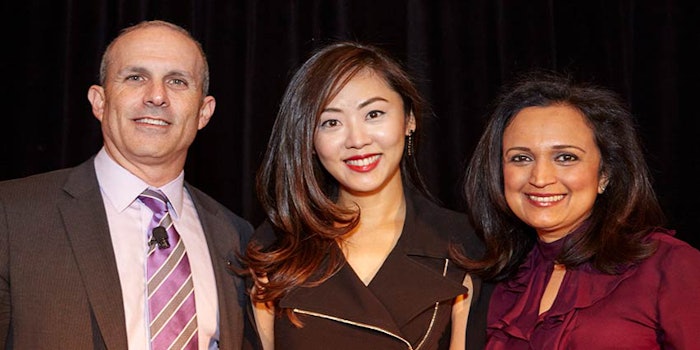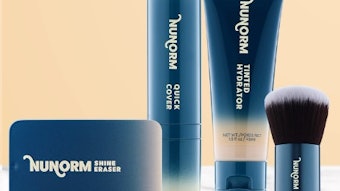
K-beauty represents a booming market opportunity in the United States, of course, but its influence could be much larger for U.S. brands, according to Priya Venkatesh, VP/DMM skin care/hair care and merchant product innovation at Sephora.
Speaking at CEW’s recent K-beauty forum in New York, the executive noted that Western brands could learn a lot from their counterparts in Seoul, namely:
- Clear messaging
- Sensorial product design and marketing
- Creating millennial-friendly skin care
- Engaging consumers with skin care education
K-beauty: By the Numbers
According to Kline Group, U.S. K-beauty sales rose 27% between 2015 and 2016, with 80% of sales coming from skin care, and another 17% coming from makeup. Through 2021, the U.S. K-beauty market is expected to expand by a further 16%.
Today, the U.S. category is extremely consolidated, with 80% of sales coming from the top four K-beauty brands, according to Kline. AmorePacific alone comprises 35% market share with brands such as Aritaum, Sulwhasoo, Laneige and IOPE. This presents a significant opportunity for brands to step in and take market share.
While Americans may never adopt 15-step skin care rituals, said Venkatesh, they will be open to easy, quick-acting solutions such as essences, if presented with the right opportunity.
Indeed, the category is set to heat up as it expands across all channels, from department stores (ex: Peach & Lily x Macy’s) to specialty retail (Sephora and Ulta) to big box retailers (Mizon and Laneige at Walmart and Target, and Masque-ology at Walmart) to branded boutiques (Aritaum, Peach & Lily at Macy’s) and home shopping (QVC).
Venkatesh noted that Sephora’s merchandising teams make careful judgements about what to launch, when and whether the market is ready. In the case of K-beauty, she said, makeup-ready skin care, milk peels that take the scare out of peeling and primers are easy bets.
Amorepacific, which has had immense success with its cushion technology, is set for its busiest year yet, according to president and CEO Bradley Horowitz. He noted it will be launching Laneige into Sephora in September, and expanding channels for the Laneige Two Tone Lip Bar.
Horowitz noted that the five largest beauty markets are Japan, China, Europe, the United States and Brazil, and that AmorePacific does most of its current business in Korea and China, meaning there is significant growth potential for its brands.
Lee noted that many K-beauty brands employ fermented ingredients (in line with the country’s cuisine heritage) to render smaller molecules that can penetrate deeper into the skin and, simultaneously, require fewer added preservatives.
With compounded growth in the United States of about 30%, Horowitz said it is conceivable that AmorePacific’s global sales could one day rise to as much as $12 billion. The big challenge today, he concluded, is telling the right skin care story to the American consumer.
To that point, Sarah Lee, co-CEO and co-founder of Glow Recipe noted that her company’s mission is to partner closely with brands and help position them for maximum relevance with American consumers. She says the company has helped companies rebrand, repackage or even reformulate in order to translate and localize K-beauty to the States.
While the category is certainly robust, what takeaways can other brands use to make themselves more competitive? The CEW panel offered several insights.
1. Skintertainment and Millennials: Make it Fun, Easy and Effective
Seoul is the Silicon Valley of skin care, said Venkatesh, while color cosmetics represent a far smaller portion of the category in the United States. There are good reasons for this.
Lee noted that America’s diverse range of skin tones are “a mystery” to K-beauty brands accustomed to a more homogenous culture. Overcoming this learning curve will require significant work, she added.
Meanwhile, said Venkatesh, Americans in general and young people in particular lack proper skin care education. K-beauty could offer solutions, she continued, particularly by clearly communicating benefits, making promises the brands can keep, and by offering quick results and engaging education via tutorials and other social media assets.
Consumers are concerned about the water content of their products.
While Americans may never adopt 15-step skin care rituals, said Venkatesh, they will be open to easy, quick-acting solutions such as essences, if presented with the right opportunity.
Glow Recipe, said Venkatesh, has helped bring K-beauty to the masses via packaging, communication, and the use of unusual ingredients and formats—all of which adds up to an attractively unusual proposition that renders skin care highly visual and creates easy-to-tell stories that let consumers have fun while caring for their skin. Lee termed this concept “skintertainment.”
This, said Venkatesh, is an inspiration for all skin care brands.
K-beauty provides a fun entry point into skin care for younger consumers, said Venkatesh. By offering millennials makeup-ready skin, K-beauty is able to create interest in these sought-after consumers.
K-beauty enhances its appeal further by offering affordable, quality and engaging products that easily convert consumers, and by producing products that are formulated for the general market, making many of them universally safe for a diverse array of consumers.
2. Visible Innovation
As J.One’s Black Jelly overnight rescue mask showed, K-beauty does a great job of pushing the visibility of its ingredients, said Venkatesh. From snail mucus to maple syrup to charcoal to artichoke (the latter for pore refining), the category is rich with highly sensorial components.
Horowitz noted that AmorePacific has long formulated its products with Asian botanicals such as green tea, red ginseng, soybeans and red beans, which resonate with consumers focused on wellness and health. The company’s Sulwhasoo brand leverages ginseng-extracted compound K, which has anti-wrinkle and anti-aging properties and is the subject of several AmorePacific patents.
Only 1% of beauty launches are making anti-pollution claims, representing a huge opportunities for brands to step into the breach.
AmorePacific also farms its own green tea on Jeju Island, said Horowitz, and produces a proprietary Osulloc green tea beverage. EGCG, an antioxidant, can be extracted from the green tea and stabilized for skin care applications.
Finally, said Horowitz, consumers are concerned about the water content of their products. AmorePacific addresses this issue by replacing water bamboo sap, which possesses its own hydrating qualities.
Lee noted that many K-beauty brands employ fermented ingredients (in line with the country’s cuisine heritage) to render smaller molecules that can penetrate deeper into the skin and, simultaneously, require fewer added preservatives.
According to a 2016 report from Mintel’s Sarah Jindal, only 1% of beauty launches are making anti-pollution claims, representing a huge opportunities for brands to step into the breach. Lee noted that K-beauty can offer pollution defense, protection from free radicals, as well as anti-UV activity.
K-beauty products photograph well, magnifying their impact for young social media-savvy consumers.
AmorePacific, meanwhile, defends against free radicals with antioxidants and unique ingredients such as lotus.*
AmorePacific also leverages pine mushroom extract to “protect the skin from irritation [inflammation] caused by environmental aggressors,” according to the brand, a technology that is featured in its Future Response Age Defense Serum.
3. Sensorial Boom
One of K-beauty’s market advantages is its sensoriality, which can communicate both function and ingredients to consumers. For instance, said Lee, products such as J.One’s Black Jelly overnight rescue mask has a dark color that reflects its key ingredients, including black cumin seed, blackcurrant and blackberry. And its name connotes the sensory experience the consumer can expect when using the product.
Korean consumers are looking for increasing levels of ease and efficiency in their routines.
Venkatesh explained that unique, sensorial formats such as jarred BB creams, aqua balms and puddings have been a big hit with Sephora’s consumers because product names tend to “say what they are” in a highly evocative way. Echoing Lee’s comments, Venkatesh explained that K-beauty products photograph well, magnifying their impact for young social media-savvy consumers.
Horowitz added that products like AmorePacific’s Time Response Skin Renewal Fluid has all the benefits of a cream, including density and high oil, but with the benefits of a liquid moisturizer. Because of the way the product is formulated, it is categorized as an emulsion, not as a cream.
4. Closing the Ritual Gap
Lee travels to Korea six or seven times a year, scouting the latest K-beauty innovations. She noted that, while the conventional Korean beauty ritual involves 15 steps, including toners, serums, sunscreens and more, many Koreans don’t commit to the full regimen.
Like their American counterparts, Korean consumers are looking for increasing levels of ease and efficiency in their routines, primarily through hybrid or multi-hyphenate products that don’t force them to sacrifice efficacy for convenience.
“[S]even layers of your toner are patted on and layered in succession.”
Products cited by Lee included masks that hydrate and peel the skin, multitasking priming moisturizers and products that can be applied in the show and hydrate, balance and tone the skin simultaneously. Korean consumers, like their American counterparts, are looking for high-quality ingredients and visibly natural skin care that makes its claims visible on its label and packaging.
5. K-disruption: The 7 Skin Method
K-beauty fanatics are always experimenting and self-creating new rituals that catch fire on social media via photos and tutorials. The latest is the 7 Skin Method, which, according to Glow Recipe, can be summarized as: “seven layers of your toner are patted on and layered in succession.” And, just like that, the user is reportedly left with healthy, hydrated skin that may not require any further moisturization.
The method, good for oily skin since it does not require creams or oils, was featured by Glow Recipe, which shared a tutorial and review, generating extensive consumer engagement. Glow Recipe’s favored toner for the 7 Skin Method sold out multiple times in one month on the basis of this trend alone.
According to Lee, the recipe was simple: introduce something disruptive, fun and effective and let the consumers run wild with it.
6. Sleeping K-beauty
Beautifying while asleep is a major K-beauty opportunity, said Horowitz. He noted that these products, such as multifunctional overnight eye and lip masks, fit easily into people’s busy lifestyles.
*Recently, Ashland introduced a natural and multifunctional anti-aging ingredient, Harmoniance (INCI: Nelumbo nucifera Extract), which was developed by capturing the biologically active benefits of the sacred lotus plant. The ingredient is intended for age-defying facial care creams to brighten skin tone, enhance skin texture, improve skin contouring and reduce wrinkles.










